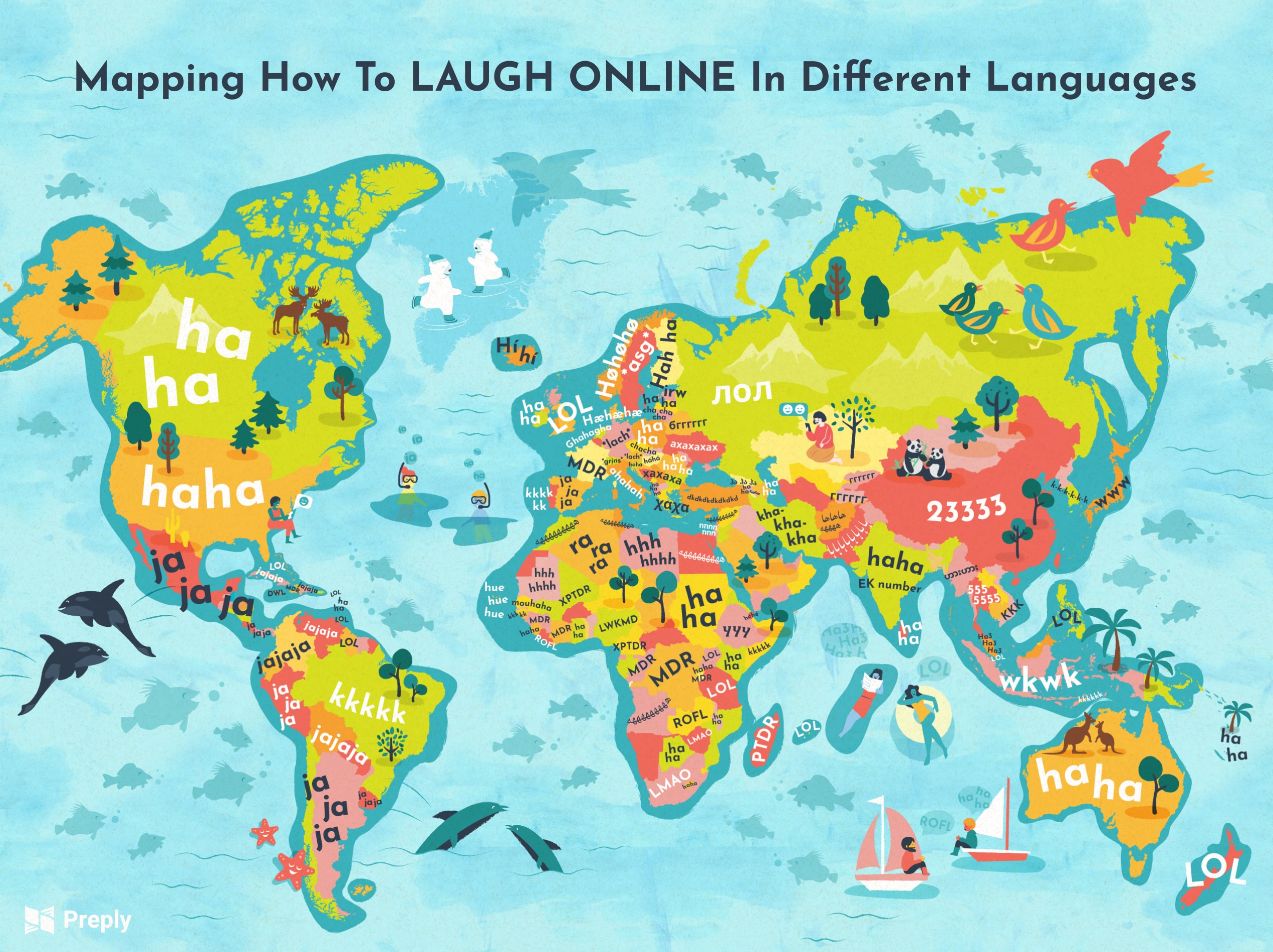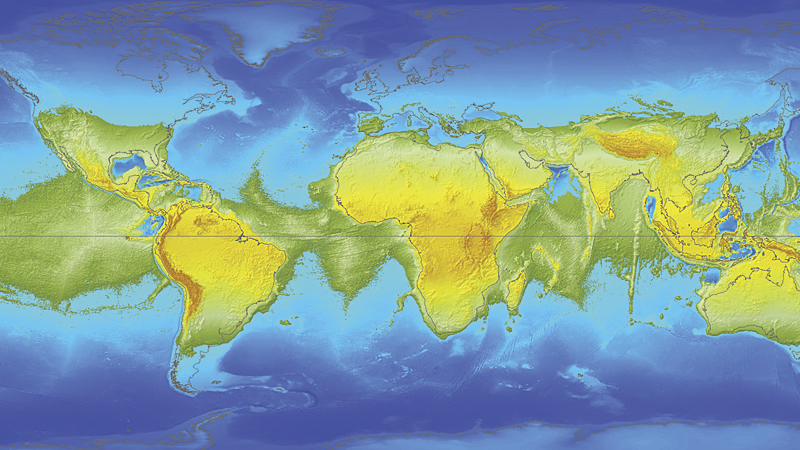Lol, jaja, xaxa, and all the other ways people laugh around the world

- Laughter is universal, unless you try to express it in written form.
- This map shows variants for things as seemingly self-evident as “LOL” and “haha.”
- So next time you’re cracking up online, why not go “23333” or “wkwk” instead?

“[Man] alone suffers so deeply that he had to invent laughter,” according to Nietzsche. Recent research contradicts the self-styled philosopher with a hammer. In its May 2021 issue, the journal Bioacoustics published a UCLA study that lists 65 different animals who also laugh — though not necessarily at all the same jokes.
“Vocalizing while at play”
And it’s not necessarily something we humans would recognize as laughter. Defined loosely as “vocalizing while at play,” animal laughter can sound like clicking, panting, or chuckling, among other things. Tickle a rat, and it emits ultrasonic squeaks. Only other primates, and especially chimpanzees, produce laughs that sound somewhat like ours.
Like them, we were born with the ability and inclination to laugh. Babies as young as three months do it. And as it is with other animals, human laughter also serves a social function. Laughter is 30 times more frequent in social situations than in solitary ones.

In fact, laughter serves as a conversational lubricant. That’s why it’s contagious — even if, according to the research cited above, only 10% to 15% of commentary is actually funny. (Although, it’s questionable how the researchers determined this — it’s all in the delivery, you know.)
Laughter is universal — up to a point
Humans have various ways of laughing. Sometimes we snort; on other occasions, we chuckle or guffaw. But the gold standard in cachinnation (to use the humorless term for laughing) is the classic belly laugh. No matter what this map tells you, those sound exactly the same the world over. In other words, strip away the physical differences, personal tics, and social expectations that “personalize” our laughs, and a spontaneous ha-ha-ha in Milan is indistinguishable from one in Moscow.
Thus, laughter is universal, but that ends when we attempt to put that sound into words. Then, as demonstrated by this map, the Tower of Babel effect kicks in. The map was made by Preply, an online language learning platform. They examined how 26 of the world’s major languages transcribe laughter online.
The results fall into two main categories: onomatopoeia and description. The first term is a word that names a thing after the sound it makes (for instance, “cuckoo” or “murmur”). Ironically, the second term speaks for itself. Some descriptions are initialisms (for example, “LOL,” which is also used in other languages).

Onomatopoeias and laughing like you’re emoji #233
Many languages use onomatopoeias, obviously using their own phonetic rules, which may look weird to non-native speakers. Take for example jajaja in Spanish, høhøhø in Norwegian or kkkkk in Portuguese. (The letter k is pronounced “kah” in Portuguese, and a string of them sounds like a hard laugh.) Curiously, Korean also uses kkkkk, as the Korean letter keu (크) is used to express laughter.
Greek and Ukrainian laughs look like a weird variant of the tic tac toe game, but that’s just them saying haha (or ahah) using their non-Latin alphabet. We’re not quite sure what Belarusian is doing. It looks like they’re freezing instead of laughing. (Actually, it transliterates as bgggg, which is meant to sound like a particularly sardonic laugh.)
Mandarin (Chinese) has various accepted modes of expressing laughter in written form online. There’s onomatopoeia, with a choice between haha (哈哈), hehe (呵呵), and hihi (嘻嘻). The mode represented here is a string of numbers: 23333. This refers to #233 in an old lineup of emojis, that particular one laughing crazily. Thai also uses numbers — a bunch of fives — but onomatopoeically: The number five is pronounced “ha.”

Japanese uses www, which transliterates, abbreviates, and repeats the word warai, i.e. “laugh.” Funnier jokes get more w’s — a principle often repeated by other languages also using abbreviations. In Bahasa Indonesia, wkwk has recently replaced haha as the cooler way of laughing online — weirdly, not as an abbreviation of anything else, but as a different representation of the same sound.
In French, onomatopoeias (hahaha, héhéhé, hihihi, or hohoho) seem to have fallen out of fashion in favor of initialisms like MDR (short for mort de rire, which is literally “died laughing”) and xptdr, a contraction of xpldr (explosé de rire) and ptdr (pété de rire), both meaning “exploded from laughing.” Senegal, also in the Francophone camp, goes for mouhaha, which is more of an evil-genius kind of laugh.
The English LOL is quite popular in other languages as well. Russian uses it (but in Cyrillic script, ЛОЛ). Other Anglo usages include haha and LMAO (“laughing my ass off”). Nigerians often use LWKMD, which is short for the phrase in pidgin English “laugh wan kill me die,” which is equivalent to “laughing to death.” In Jamaica, a popular acronym is DWL, short for the local slang “dead wid laugh.” Liberians, for their part, prefer to ROFL (“roll on floor laughing”). Swedish asg is short for asgarva (“laughing intensely”). Similarly, German uses lach and grins.
“I rate this joke number one”
On the Indian internet, laughter transcribes as haha or as EK number — “ek” is Hindi for the number one, and the phrase translates loosely as, “I rate this number one,” a common Indian response to a good joke.
Ha3 means three times “ha,” making the popular phrase in Malaysian (Ha3 Ha3 Ha3) either overly enthusiastic or somewhat redundant.

There’s no clear explanation why Turkish uses dkdkd, but other evidence suggests you can also just type a random sequence of characters, expressing the sentiment: “I laughed so hard, I fell on the keyboard.” Oh, and that fishbone symbol in Egypt, Syria, and a few other places? That’s not an error. It’s the Arabic letter “h,” repeated a bunch of times.
Finally, the map has a nice touch: It includes New Zealand, which is left off so many others, that the phenomenon has its own subreddit. It looks like this time they get to have the last laugh. Out loud.
Strange Maps #1156
Got a strange map? Let me know at strangemaps@gmail.com.
Follow Strange Maps on Twitter and Facebook.





